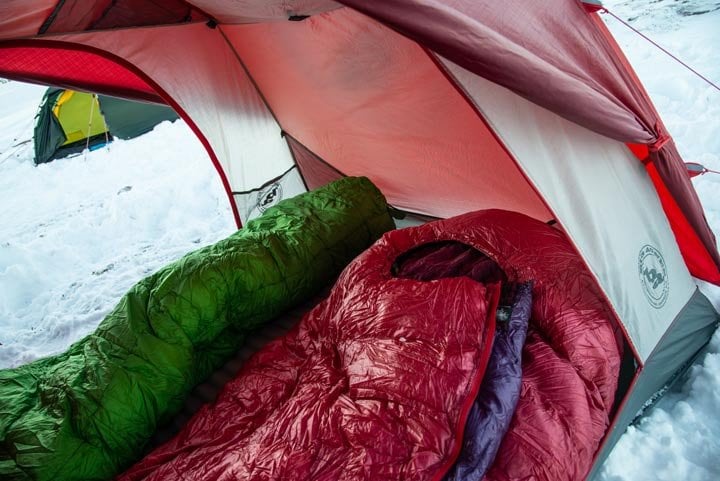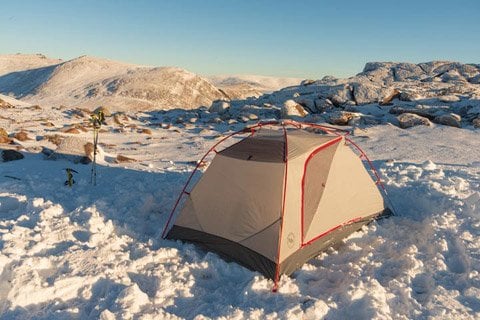Cairngorm Treks Review - Big Agnes Copper Spur HV2 Expedition
Posted by Cairngorm Treks on Feb 11, 2019
Extensively tested and reviewed by Cairngorm Treks throughout late summer to winter 2018/19 in the Cairngorms, and surrounding mountainous regions.
If you're familiar with the Copper Spur HV series, then you will instantly recognise the distinctive shape of the latest edition of this popular shelter. Big Agnus claim the HV2 Expedition to be a beefed up, burly, take-anywhere version, ready for the toughest conditions on the planet. This is a big statement for a tent that claims to be a 4-season, 2-person tent, with a weight of only 2194 grams. We have spent many winter nights out in what we would class as 4 season tents,with most usually packing in at nearly twice this weight and bulk, so we were intrigued to see how this edition to the Copper Spur HV range would perform.

Initial impressions are a bit sceptical as the HV2 Expedition doesn’t follow the usual designs that most other 4 season tents adopt and is quite high for its size and box-like in shape similar to their 2/3-season tents. Using a DAC Featherlite NSL pole system, which comprises of 4 poles all attached to a central pivot point again shows similarities to the rest of the HV series. This shape and structure have worked well for them in the past, with the Copper Spur range well regarded for its stability against the elements. But how would it fair up to large amount of snow loading? Where Big Agnus have strengthened this system is by increasing the pole thickness to 9.6mm.
External and internal fabrics have also been upgraded to a more robust and secure set up. The fly is silicone treated proprietary patterned random rip-stop nylon with a 1200mm waterproof polyurethane silicon coating. To the touch, the fly feels more like what we would expect from a 4-season shelter, with a revolutionary unique weave made with a high tenacity yarn and high filament count that Big Agnus claim increases fabric tear strength by 25%.
The HV2 Expedition is very easy to pitch and after just a couple of practice runs at home, you'll be able to set up this tent in under 5 minutes with two people, or under 10 minutes solo. This is a tent that requires the inner to be pitched before the fly, so please remember before heading out and getting caught in harsh conditions it’s best to be completely familiar with the process to mitigate unwanted moisture penetrating the inner fabric. The pole system easily clicks together and slots into the corners of the base. Lightweight plastic clips attach the inner to the pole structure and can easily be attached even whilst wearing gloves. A smaller pole can then be placed into position with its own unique clips creating vertical walls. An issue to highlight regarding the poles was at the end of a three-day expedition in very cold conditions, when it came to packing the tent away, we had great difficulties separating the poles. They were frozen solid and took two of us pull them apart. For future use we applied a small coating of Vaseline to prevent this issue.
The fly is colour coded, with tension-able clips located at the corners that connect the fly to the inner. For extra security against the wind, interior guy loops can be attached, although we found this system to be fiddly and hard to implement whilst wearing gloves. The rest of the fly can then be staked out and even before the guy lines are in position the HV2 Expedition sits impressively solid.
Big Agnus haven't held back on making this one of their most secure tents with a massive 14 stake points in total. The stars of the show are the dual, equalized Dyneema guylines. We use Dyneema guylines throughout all our shelters as they are very light, extremely strong, but most importantly they absorb no moisture so won't freeze whilst camping at minus temperatures. Add to this the large aluminium J stakes included, and this becomes a very stable combination.
Throughout late summer and winter we have used the HV2 Expedition in some dire conditions. Once pitched correctly we have no doubt this shelter can easily handle strong wind speeds, and heavy rainfall, with us having a particularly pleasant nights camp on the Monadhliath in wind speeds of around 50-60mph. The box shaped design we were initially worried about flexes with the wind, adapting its shape, so that any gusts simply slip along the sides. Tucked up in your sleeping bag you would hardly notice what's going on outside.
There are a couple of weaker points which should be noted. The doors rely on tension and have no aid from a pole to provide stability. If wind directions do change, or in heavy snowfall, expect a lot more give in this area than the rest of the tent, so keep a shovel handy just in case a trip out in the night is needed.
The inner is a proprietary patterned random rip-stop nylon breathable and 20D polyester mesh with a nylon rip-stop bathtub with a 10,000mm waterproof polyurethane coating. Again, this is much more than what we would expect from a shelter geared towards the colder months. We are big fans of having two entry points, especially within a base camp shelter where much time could be spent within this space. A quick stash door keeper on the tent body door is a great addition and provides an easy and quick solution.
The attention to detail continues throughout the sleeping area as there are a massive 10 interior mesh pockets. They are well placed but,unfortunately, we would have preferred fewer pockets but have them larger in size. They are OK for smaller items such as a head torch, wash kit, small bag of essentials, but throughout winter we would like larger pockets capable of fitting in a duvet jacket or spare clothing. The HV2 Expedition is labelled as a base camp tent and we would expect more storage options rather than a design more suited to 3-seasonwild-camping. These may seem like minor details but over the course of an extended trip in minus temperatures, being able to properly organise equipment is of great importance.
An aspect we have not seen before within mountain tents are the 2 media pockets located at the ceiling with small holes to allow access for headphones, and there is even the option to add an internal lighting system. Is this a sign of modern times with more tech being added to mountain shelters? We’re not quite sure what to make of all this just yet.

Ventilation is a key factor to winter camping with many nights ruined as a build-up of condensation can wet your gear reducing its thermal qualities. The HV2 Expedition is one of the best shelters we have come across to dealing with this issue. A large closable ceiling and door vents provide good air circulation and can also be completely closed up to suit your environment. These vents also double up as viewing windows, so you can see what's happening outside without having to open up a door and letting out the built-up warmth from inside. A large vent on the fly itself and also vestibule doors further add a flow of air which is directed away from the people inside. We used the HV2 Expedition throughout the autumn and winter seasons in varying temperatures with an occupancy of 1 or 2 people. Never once did we have any issue regarding condensation and were quite astonished at how well balanced warmth, air flow, and condensation could be controlled.
For all the great interior features and comforts unfortunately the living space just isn't large enough for two people with full winter gear. Inside dimensions are large enough to fit two people with some gear stored in the mesh pockets but larger items need to be stored in the vestibule. Without the two side entrances pulling tight to the ground, or with the aid of snow skirts, snow and ice easily covered any gear we had stored here. Throughout winter we prefer a to use a tent in which all of our gear can be stored inside, keeping it dry and easy to access. For solo use there's a great amount of space, and as a base camp tent for winter this is our much-preferred set up. Head height is around 1m, and with the vertical walls makes a great living space to change clothes, plan routes, eating, etc. With two people inside, things get a bit constrictive, and having to spend time like this over an extended trip would become difficult. There is a large amount of gear lofts available which can be purchased separately. This could help with this issue, but as we didn't have any of these available, we have to base this review on the products we used at the time.
The guylines and attachment points have reflective tape which is great for not tripping over at night. Whilst on a recent trip, which involved a bit of night navigation, we returned to our camp to find that Big Agnus had included another, and much larger reflective surprise: The Big Agnus logo placed on the fly; once fused with the light of a headlamp it is bright enough to be seen from space. Finding camp at night is made easy.





Cairngorm Treks is a small family business based in the picturesque village of Tomintoul in the North East region of the Cairngorms National Park. They provide bespoke Mountain Guiding for Single Day Walks and Lightweight Multiday Trekking experiences, including wild camping, in the stunning Cairngorms wilderness and surrounding areas. Whether in the high mountains or lower valleys, their Multiday Treks are equipped with high quality, lightweight camping and trekking gear. They only work with small groups and, whatever your ability, pride themselves on designing your outdoor experience completely to your needs and with professional guidance and expertise. Adventure is waiting...
Extensively tested and reviewed by Cairngorm Treks throughout late summer to winter 2018/19 in the Cairngorms, and surrounding mountainous regions.
If you're familiar with the Copper Spur HV series, then you will instantly recognise the distinctive shape of the latest edition of this popular shelter. Big Agnus claim the HV2 Expedition to be a beefed up, burly, take-anywhere version, ready for the toughest conditions on the planet. This is a big statement for a tent that claims to be a 4-season, 2-person tent, with a weight of only 2194 grams. We have spent many winter nights out in what we would class as 4 season tents,with most usually packing in at nearly twice this weight and bulk, so we were intrigued to see how this edition to the Copper Spur HV range would perform.
